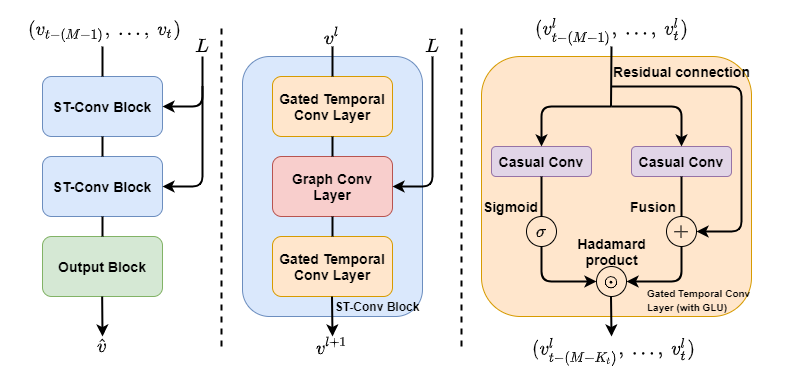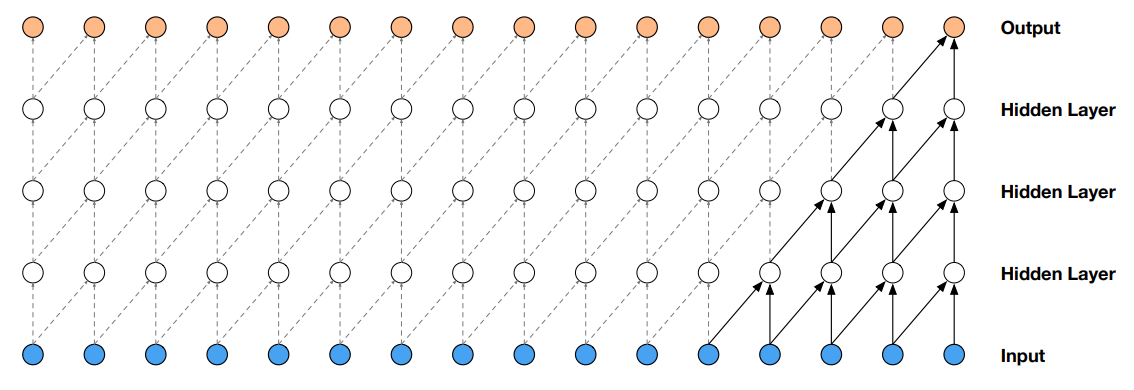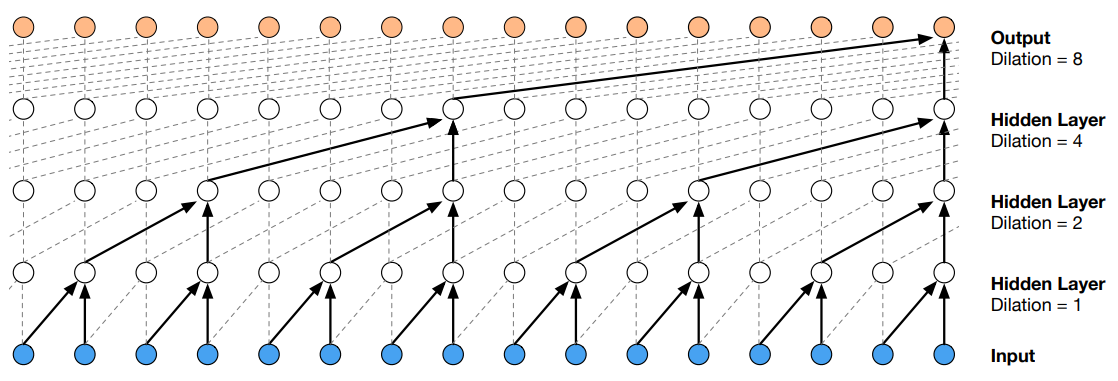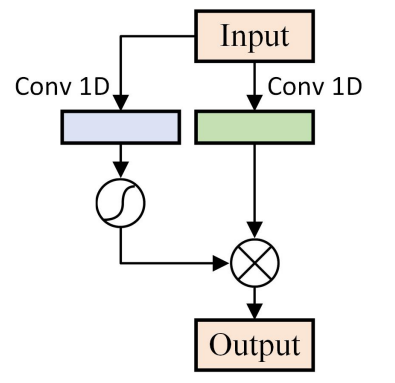Spatio-Temporal Graph Convolutional Networks 详解
最近,我在找寻关于时空序列数据(Spatio-temporal sequential data)的预测模型。偶然间,寻获论文 Spatio-Temporal Graph Convolutional Networks: A Deep Learning Framework for Traffic Forecasting,甚喜!因此想基于这个模型,改为我所用。但是,我查询了网上的很多关于 STGCN 的解析,发现都不够详细,很多关键的细节部分一笔带过。由是,我写下这篇文章,详细说明我对 STGCN 论文的理解,和如何将原作者用 TensorFlow v1 实现的模型用 PyTorch 重构一遍。
请注意,本篇讲解的是 STGCN,不是 ST-GCN!前者是用于「交通流量预测」,后者是用于「人体骨骼的动作识别」。名字很像,但是模型不一样。
一、论文解析
STGCN 开创性地采用 Graph Convolution 和 Gated Causal Convolution 的组合,不依赖 LSTM/GRU 来做预测。原论文的模型架构图,如下所示。

我们可以看到整个架构由三部分组成,原作者的图画得不够清晰。我放上我自己制作的图,如下所示。

在论文中,我们可以知道,整个架构其實是「输入 —— ST-Conv Block —— ST-Conv Block —— Output Block —— 输出」。
1.1 ST-Conv Block
每一个 ST-Conv Block 是由两个 Gated Temporal Convolution layer 夹着一个 Graph Convolution layer 组成。之所以,TGC 的 channel number 是 64,SGC 的是 16,是因为原作者认为这种「三明治」结构既可以 achieve fast spatial-state propagation from graph convolution through temporal convolutions,又可以 helps the network sufficiently apply bottleneck strategy to achieve scale compression and feature squeezing by downscaling and upscaling of channels C through the graph convolutional layer.
2.1 Graph Convolution layer
从源代码来看,就是 Graph Convolution + Residual Connection。原作者采用了 ChebConv 和 GCNConv ,但是原作者对 GCNConv 的理解有误,论文中的公式和代码都写错了。
2.2 ChebConv(默认使用 \mathbf{L}_{\mathbb{norm}} = \mathbf{L}_{\mathbb{sym}} = \mathbf{D}^{-\frac{1}{2}}\mathbf{L}\mathbf{D}^{-\frac{1}{2}} =\mathbf{I}_{n} - \mathbf{D}^{-\frac{1}{2}}\mathbf{A}\mathbf{D}^{-\frac{1}{2}},也可以使用 \mathbf{L}_{\mathbb{rw}} = \mathbf{D}_{row}^{-1}\mathbf{L} = \mathbf{I}_{n} - \mathbf{D}_{row}^{-1}\mathbf{A} )
采用 Chebyshev polynomials of the first kind (第一类切比雪夫多项式)近似卷积核: g_{\theta}(\mathbf{\Lambda}) \approx \sum^{K-1}_{k=0}\theta_kT_k(\widetilde{\mathbf{\Lambda}}) , \widetilde{\mathbf{\Lambda}} = \frac{2\mathbf{\Lambda}}{\lambda_{max}} - \mathbf{I}_{n} 。
其递推公式为 T_k(x) = 2xT_{k-1}(x) - T_{k-2}(x) ,其中 T_0(x) = 1 , T_1(x) = x 。Graph convolution kernel size K_s 与 order of Chebyshev polynomials K_{cp} 不一致,因为前者是从 1 开始计数,而后者是从 0 开始计数。因此, K_s = K_{cp} + 1 。在公式和代码中,我用 K 代表 K_{s} ,注意 K \in [1,\ |\mathcal{V}|] 。
将卷积核公式代入原谱卷积公式中,得
\begin{split} g_{\theta}(\mathbf{L}_{\mathbb{norm}})\mathbf{x} &\approx \mathbf{U}\sum^{K-1}_{k=0}\theta_kT_k(\widetilde{\mathbf{\Lambda}})\mathbf{U}^T\mathbf{x} \\ &\approx \sum^{K-1}_{k=0}\theta_kT_k(\mathbf{U}\widetilde{\mathbf{\Lambda}}\mathbf{U}^T)\mathbf{x} \\ &\approx \sum^{K-1}_{k=0}\theta_kT_k(\widetilde{\mathbf{L}}_{\mathbb{norm}})\mathbf{x} \end{split}
其中 \widetilde{\mathbf{L}}_{\mathbb{norm}} = \frac{2\mathbf{L}_{\mathbb{norm}}}{\lambda_{max}} - \mathbf{I}_n 。为了使得时间复杂度从 O(n^2) 降至 O(K|\mathcal{E}|) ,ChebyNet 的作者提出用递推的写法,公式如下:
\bar{x}_{k} = 2\widetilde{\mathbf{L}}_{\mathbb{norm}}\bar{x}_{k-1} - \bar{x}_{k-2} ,其中 \bar{x}_{0} = x , \bar{x}_{1} = \widetilde{\mathbf{L}}_{\mathbb{norm}}x 。
g_{\theta}(\mathbf{L}_{\mathbf{norm}})\mathbf{x} \approx [\bar{x}_{0},\ ...,\ \bar{x}_{K-1}]\mathbf{\Theta}
2.3 GCNConv
当我们把 ChebyNet 的图卷积公式中的 order K - 1 = 1 (即 K_{s} = 2 )时,原式写作
g_{\theta}(\mathbf{L}_{\mathbb{norm}})\mathbf{x} \approx \mathbf{x}\mathbf{\Theta}_{0} + (\mathbf{L}_{norm}-\mathbf{I}_{n})\mathbf{x}\mathbf{\Theta}_{1} = \mathbf{x}\mathbf{\Theta}_{0} - (\mathbf{D}^{-\frac{1}{2}}\mathbf{A}\mathbf{D}^{-\frac{1}{2}})\mathbf{x}\mathbf{\Theta}_{1}
令 \mathbf{\Theta} = \mathbf{\Theta}_{0} = -\mathbf{\Theta}_{1} ,则原式化简为
g_{\theta}(\mathbf{L}_{\mathbb{norm}})\mathbf{x} \approx (\mathbf{I}_{n} + \mathbf{D}^{-\frac{1}{2}}\mathbf{A}\mathbf{D}^{-\frac{1}{2}})\mathbf{x}\mathbf{\Theta}
因为 \mathbf{I}_{n} + \mathbf{D}^{-\frac{1}{2}}\mathbf{A}\mathbf{D}^{-\frac{1}{2}} 的特征值 \in [0,\ 2] ,为防止梯度消失(梯度弥散)或梯度爆炸(这是写在 paper 中的说辞,实际原因是此为 high-pass filter),采用 renormalization trick(重归一化技巧),即
\mathbf{I}_{n} + \mathbf{D}^{-\frac{1}{2}}\mathbf{A}\mathbf{D}^{-\frac{1}{2}} \rightarrow \widetilde{\mathbf{D}}^{-\frac{1}{2}}\widetilde{\mathbf{A}} \widetilde{\mathbf{D}}^{-\frac{1}{2}} ,其中 \widetilde{\mathbf{A}} = \mathbf{A} + \mathbf{I}_{n} , \widetilde{\mathbf{D}}_{ii} = \sum_{j} \widetilde{\mathbf{A}}_{ij} 。
所以,原图卷积公式可以进一步近似为
g_{\theta}(\mathbf{L}_{\mathbb{norm}})\mathbf{x} \approx g_{\theta}(\hat{\mathbf{A}})\mathbf{x} = \hat{\mathbf{A}}\mathbf{x}\mathbf{\Theta} ,其中 \hat{\mathbf{A}} = \widetilde{\mathbf{D}}^{-\frac{1}{2}}\widetilde{\mathbf{A}}\widetilde{\mathbf{D}}^{-\frac{1}{2}} 。
每层图卷积的时间复杂度为 O(|\mathcal{E}|) 。
3.1 Temporal Gated Convolution layer
Temporal Gated Convolution layer 是由 Casual Convolution 和 Gated Linear Unit (GLU) 组合而成。
与典型的 GLU 不同的是,其中的 1D Convolution 被 Casual Convolution 所取代,最后的 convolution 被 Hadamard Product 所取代。原论文中提到的 Residual Connection ,并不接在 Hadamard Product 之后,而是与 Casual Convolution 之后产生 P 的那一段相连,使得原始输入与 P 融合。
3.2 Casual Convolution 和 Dilated (Casual) Convolution
Casual convolution: convolutions where an output at time t is convolved only with elements from time t and earlier in the previous layer.

Dilated (casual) convolution 定义为 F(s) = (\textbf x *_{d} f)(s) = \sum^{k-1}_{i=0}f(i) \cdot \textbf x_{s-d \cdot i}

3.3 Gated Linear Unit (GLU) 和 Gated Tanh Unit (GTU)

Gated linear unit (GLU): 将输入序列分成两部分,分别经过 1D-conv,之后,一部分经过 Sigmoid,另一部分直出,然后两者经过一次 convolution,最后输出。公式如下: h_{l}(X) = (X * W + b) \otimes \sigma(X * V + c)
PyTorch 团队提出,其实作应为 \mathbf{X}_{a}\odot\sigma(\mathbf{X}_{b})
Gated Tanh unit (GTU): 类似于 GLU,GLU 中线性的部分换为 Tanh。公式如下:
h_{l}(X) = tanh(X * W + b) \otimes \sigma(X * V + c)
有人认为,应实作为 \tanh(\mathbf{X}_{a}) \odot \sigma(\mathbf{X}_{b})
4.1 weighted adjacency matrix
STGCN 的作者并没有理解 GNN(从他把 GCN 当作是 1^{st} order ChebyNet 就可以看出来 ),把计算「带权重的邻接矩阵」的公式搞错了,我强烈建议你采用 ChebyNet 所提供的计算公式。公式如下:
w_{ij}=\left\{ \begin{aligned} \exp(-\frac{{[\mathbb{dist}(v_i,\ v_j)]}^2}{\sigma^2}), && \mathbb{if} \ \mathbb{dist}(v_i, v_j)\le k \\ 0, && \mathbb{otherwise} \end{aligned} \right.
二、代码解析
1.1 model 整体架构
由于原 paper 所写 model 有两个,分别是用 ChebNet 和 GCN 的 Graph Convolution 的 STGCN,原作者定义为 STGCN(Cheb) 和 STGCN( 1^{st} ),我在代码中定义为 STGCN(ChebGraphConv) 和 STGCN(GraphConv)。
Causal Convolution
class CausalConv1d(nn.Conv1d):
def __init__(self, in_channels, out_channels, kernel_size, stride=1, enable_padding=False, dilation=1, groups=1, bias=True):
if enable_padding == True:
self.__padding = (kernel_size - 1) * dilation
else:
self.__padding = 0
super(CausalConv1d, self).__init__(in_channels, out_channels, kernel_size=kernel_size, stride=stride, padding=self.__padding, dilation=dilation, groups=groups, bias=bias)
def forward(self, input):
result = super(CausalConv1d, self).forward(input)
if self.__padding != 0:
return result[: , : , : -self.__padding]
return result
class CausalConv2d(nn.Conv2d):
def __init__(self, in_channels, out_channels, kernel_size, stride=1, enable_padding=False, dilation=1, groups=1, bias=True):
kernel_size = nn.modules.utils._pair(kernel_size)
stride = nn.modules.utils._pair(stride)
dilation = nn.modules.utils._pair(dilation)
if enable_padding == True:
self.__padding = [int((kernel_size[i] - 1) * dilation[i]) for i in range(len(kernel_size))]
else:
self.__padding = 0
self.left_padding = nn.modules.utils._pair(self.__padding)
super(CausalConv2d, self).__init__(in_channels, out_channels, kernel_size, stride=stride, padding=0, dilation=dilation, groups=groups, bias=bias)
def forward(self, input):
if self.__padding != 0:
input = F.pad(input, (self.left_padding[1], 0, self.left_padding[0], 0))
result = super(CausalConv2d, self).forward(input)
return resultCheby Graph Convolution
class ChebGraphConv(nn.Module):
def __init__(self, c_in, c_out, Ks, gso, bias):
super(ChebGraphConv, self).__init__()
self.c_in = c_in
self.c_out = c_out
self.Ks = Ks
self.gso = gso
self.weight = nn.Parameter(torch.FloatTensor(Ks, c_in, c_out))
if bias:
self.bias = nn.Parameter(torch.FloatTensor(c_out))
else:
self.register_parameter('bias', None)
self.reset_parameters()
def reset_parameters(self):
init.kaiming_uniform_(self.weight, a=math.sqrt(5))
if self.bias is not None:
fan_in, _ = init._calculate_fan_in_and_fan_out(self.weight)
bound = 1 / math.sqrt(fan_in) if fan_in > 0 else 0
init.uniform_(self.bias, -bound, bound)
def forward(self, x):
#bs, c_in, ts, n_vertex = x.shape
x = torch.permute(x, (0, 2, 3, 1))
if self.Ks - 1 < 0:
raise ValueError(f'ERROR: the graph convolution kernel size Ks has to be a positive integer, but received {self.Ks}.')
elif self.Ks - 1 == 0:
x_0 = x
x_list = [x_0]
elif self.Ks - 1 == 1:
x_0 = x
x_1 = torch.einsum('hi,btij->bthj', self.gso, x)
x_list = [x_0, x_1]
elif self.Ks - 1 >= 2:
x_0 = x
x_1 = torch.einsum('hi,btij->bthj', self.gso, x)
x_list = [x_0, x_1]
for k in range(2, self.Ks):
x_list.append(torch.einsum('hi,btij->bthj', 2 * self.gso, x_list[k - 1]) - x_list[k - 2])
x = torch.stack(x_list, dim=2)
cheb_graph_conv = torch.einsum('btkhi,kij->bthj', x, self.weight)
if self.bias is not None:
cheb_graph_conv = torch.add(cheb_graph_conv, self.bias)
else:
cheb_graph_conv = cheb_graph_conv
return cheb_graph_convGraph Convolution
class GraphConv(nn.Module):
def __init__(self, c_in, c_out, gso, bias):
super(GraphConv, self).__init__()
self.c_in = c_in
self.c_out = c_out
self.gso = gso
self.weight = nn.Parameter(torch.FloatTensor(c_in, c_out))
if bias:
self.bias = nn.Parameter(torch.FloatTensor(c_out))
else:
self.register_parameter('bias', None)
self.reset_parameters()
def reset_parameters(self):
init.kaiming_uniform_(self.weight, a=math.sqrt(5))
if self.bias is not None:
fan_in, _ = init._calculate_fan_in_and_fan_out(self.weight)
bound = 1 / math.sqrt(fan_in) if fan_in > 0 else 0
init.uniform_(self.bias, -bound, bound)
def forward(self, x):
#bs, c_in, ts, n_vertex = x.shape
x = torch.permute(x, (0, 2, 3, 1))
first_mul = torch.einsum('hi,btij->bthj', self.gso, x)
second_mul = torch.einsum('bthi,ij->bthj', first_mul, self.weight)
if self.bias is not None:
graph_conv = torch.add(second_mul, self.bias)
else:
graph_conv = second_mul
return graph_conv更多的代码与细节,欢迎关注我的 GitHub repository:hazdzz/STGCN ,为了照顾大陆用户,奉上码云(Gitee)的项目链接:hazdzz/STGCN 。


